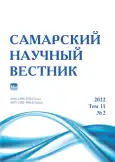Антропологические аспекты проблемы бессмертия в современной научно-фантастической литературе
- Авторы: Казакова И.Б.1
-
Учреждения:
- Самарский государственный социально-педагогический университет
- Выпуск: Том 11, № 2 (2022)
- Страницы: 257-261
- Раздел: Исторические науки
- URL: https://journals.rcsi.science/2309-4370/article/view/109859
- DOI: https://doi.org/10.55355/snv2022112217
- ID: 109859
Цитировать
Полный текст
Аннотация
В статье рассматриваются особенности интерпретации проблемы бессмертия в англоязычной научно-фантастической литературе конца XX–XXI вв. На примере творчества Р. Сойера, П. Уоттса, Г. Игана, Н. Стивенсона, В. Винджа автор анализирует различные способы рассмотрения в научной фантастике антропологических аспектов проблемы бессмертия, связанных с переосмыслением целей и смысла существования в случае реализации трансгуманистического проекта продления сроков человеческой жизни. Автор приходит к заключению, что в современной научной фантастике тема бессмертия представлена в виде двух основных вариантов: физического бессмертия, предполагающего невозможность отделения сознания человека от мозга как его материального носителя, и цифрового бессмертия, связанного с гипотетической технологией сканирования сознания и перемещения его в виртуальный мир. Рассматривая эти варианты бессмертия, писатели-фантасты обнаруживают в них как технологические, так и гуманитарные проблемы: во-первых, это недостижимость реального бессмертия, связанная с конечностью существования вселенной и (во втором варианте) с технической невозможностью вечно обеспечивать функционирование виртуального мира. Во-вторых, это признаваемая всеми перечисленными писателями проблема смысловой наполненности бессмертного существования, связанная с необходимостью для человека ставить перед собой новые долгосрочные цели, а также, в случае цифрового бессмертия, проблема переосмысления человеком, превратившимся в чистое сознание, собственной природы и принятия виртуальной реальности как единственно возможной для него. В целом способы раскрытия темы бессмертия в современной научно-фантастической литературе дают возможность увидеть в трансгуманистических концепциях бессмертия серьезную антропологическую проблему, связанную с тем, что усовершенствование физических и интеллектуальных способностей человека должно будет повлечь за собой изменение его сознания и самосознания, но предсказать характер и результат таких изменений намного сложнее, чем предсказать результаты физических модификаций человеческого организма.
Ключевые слова
Полный текст
Открыть статью на сайте журналаОб авторах
Ирина Борисовна Казакова
Самарский государственный социально-педагогический университет
Автор, ответственный за переписку.
Email: kib_sam@mail.ru
доктор филологических наук, профессор кафедры философии, истории и теории мировой культуры
Россия, СамараСписок литературы
- Шелер М. Положение человека в Космосе // Проблема человека в западной философии: переводы / сост. П.С. Гуревич; общ. ред. Ю.Н. Попова. М.: Прогресс, 1988. С. 31-95.
- Bostrom N. A history of transhumanism thought // Journal of Evolution & Technology. 2005. Vol. 14 (1). P. 1-30.
- Krueger O. Gnosis in cyberspace? Body, mind and progress in posthumanism // Journal of Evolution and Technology. 2005. Vol. 14 (2). P. 77-89.
- Дёмин И.В. Бессмертие как проект: смерть и бессмертие человека в контексте гуманистического и трансгуманистического типов мировоззрения // Онтология проектирования. 2013. № 4. С. 7-17.
- Виндж В. Грядущая технологическая сингулярность: как выжить в постчеловеческую эпоху // Виндж В. Сингулярность: сб. / пер. с англ. М. Левина, В. Гришечкина. М.: Аст, 2019. С. 3-37.
- Sawyer R.J. Rollback. New York: A Tor Book, 2008. 320 p.
- Sawyer R.J. Flashforward. New York: A Tor Book, 2014. 305 p.
- Sawyer R.J. Starplex. New York: Ace Books, 1996. 304 с.
- Уоттс П. Огнепад: Ложная слепота. Зеро. Боги насекомых. Полковник. Эхопраксия / пер. с англ. Д. Смушковича, Н. Кудрявцева. М.: Аст, 2020. 908 с.
- Уоттс П. Революция в стоп-кадрах / пер. с англ. Н. Кудрявцева, В. Женевского. М.: Аст, 2021. 347 с.
- Sawyer R.J. The terminal experiment. Toronto: Penguin Canada, 2009. 273 p.
- Egan G. Permutation city. New York: HarperPrism, 1994. 341 p.
- Egan G. Border guards // Egan G. Oceanic. London: Gollancz, 2009. P. 261-287.
- Виндж В. Куки-монстр // Виндж В. Сингулярность: сб. / пер. с англ. М. Левина, В. Гришечкина. М.: Аст, 2019. С. 63-218.
- Стивенсон Н. Падение, или Додж в аду. Книга первая / пер. с англ. Е. Доброхотовой-Майковой. М.: Эксмо, 2020. 544 с.
- Долин В.А. Трансгуманистические представления о человеке в современном антропологическом дискурсе // Знание. Понимание. Умение. 2017. № 4. С. 133-144.
Дополнительные файлы






